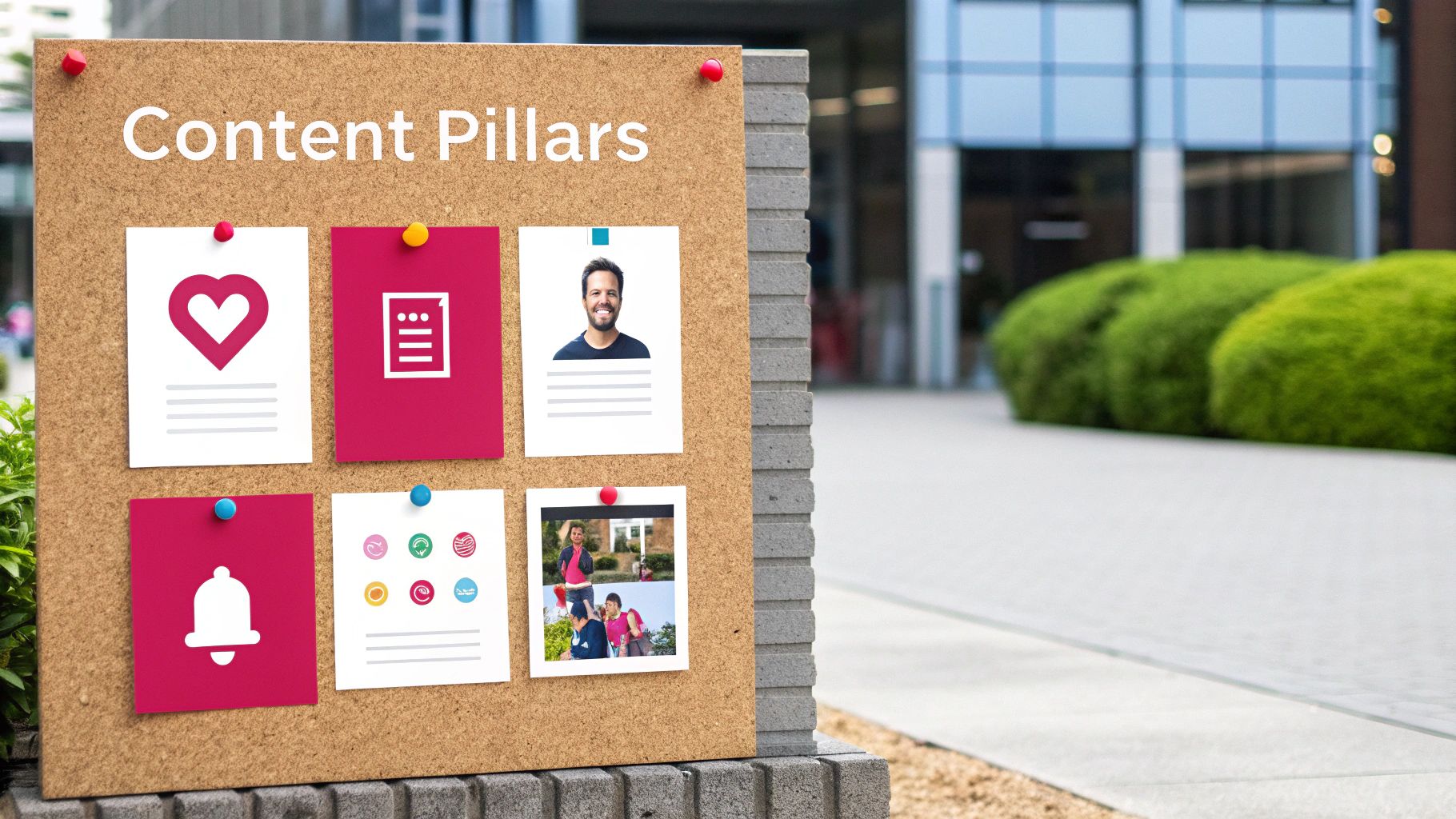A social media content strategy is, at its heart, the game plan for everything you publish on your social channels. It's much more than just randomly posting updates. Think of it as a purpose-driven framework that dictates what you say, who you're talking to, and most importantly, how every single post serves your bigger business goals.
Building Your Foundation for Social Success

Before you even think about drafting your first post, you need to lay a solid foundation. I’ve seen countless brands stumble because they dive headfirst into creating content without answering the most fundamental question: "Why are we even doing this?" A winning strategy always starts with crystal-clear objectives that are directly wired to real business outcomes.
Forget about vanity metrics like "getting more followers." You need to focus on what actually moves the needle for your business. To get started on the right foot, using a well-designed social media content strategy template can give you a clear roadmap to follow.
From Vague Ideas to Concrete Goals
The first real step is to take those broad business ambitions and sharpen them into specific, actionable social media goals. This gives every piece of content a job. When you have this clarity, you stop committing "random acts of content" and ensure every post is part of a much larger mission.
For example, I once worked with a Dubai-based e-commerce brand whose initial goal was simply "to increase sales." We refined that into something much more powerful: "drive a 20% increase in website clicks from Instagram Stories within Q3." Now that is a goal you can actually build a strategy around and measure.
A goal without a measurement is just a wish. Your social media objectives have to be quantifiable. It's the only way to prove their value and figure out what to optimize. Vague goals will always lead to vague results.
This process turns your social media from a daily chore into a strategic asset. Every decision you make—from the platforms you use to the types of videos you create—will be guided by these foundational goals.
Defining Your Core Business Objectives
To build this foundation, you have to get honest about your primary business needs. What's the priority right now? Are you trying to build an engaged community, fill your sales pipeline with leads, or position your brand as the go-to expert in your field?
Here are some common business objectives and how they translate into tangible social media goals:
- Increase Brand Awareness: This is all about getting your name out there. A smart social goal would be to increase your overall reach and impressions by 30% in the next six months by producing highly shareable, top-of-funnel content.
- Drive E-commerce Sales: For anyone selling online, this is the bottom line. A concrete goal could be to generate 500 qualified leads each month by running targeted ad campaigns on Facebook and Instagram.
- Build Brand Loyalty: This is about turning customers into fans. Your objective might be to boost your average engagement rate by focusing on rapid response times and sparking real conversations in your comments.
- Establish Industry Authority: This is a classic B2B play. A corresponding social goal could be to increase traffic to your company blog by 25% by consistently sharing insightful articles and deep-dive case studies on LinkedIn.
When you articulate these objectives clearly, you create a powerful filter for every creative idea that comes your way. Before hitting "publish," you can ask one simple question: "Does this post help us achieve our core objective?" If the answer isn't a firm "yes," it doesn't belong in your strategy.
Getting to Know Your Audience in the AE Market

If you want to truly connect with your audience, you have to go deeper than surface-level demographics. Knowing their age and where they live is just the start. The real magic happens when you understand what makes them tick—their aspirations, their daily frustrations, and the kind of content they’ll actually stop scrolling for. This is precisely where a detailed audience persona becomes the most valuable tool in your social media content strategy.
Think of a persona not as a made-up character, but as a research-backed profile of your ideal customer in the AE market. It’s about turning cold, hard data into a relatable human story. This lets you craft content that speaks to a real person, not just a faceless crowd. It’s this shift in mindset that separates brands that just shout into the void from those that build real, thriving communities.
The potential in this region is staggering. By early 2025, the Arab region is expected to have around 228 million social media users. In key markets like the UAE and Saudi Arabia, social media penetration is already north of 90%. These platforms aren't just for fun anymore; they are deeply woven into daily life and commerce. You can get a better sense of this by checking out the most popular apps for Arab internet users to see how integrated these platforms have become.
From Data Points to Detailed Personas
Building a powerful persona starts with some good old-fashioned detective work. Forget about guesswork. You need to gather clues from different sources to piece together a full picture of who you're talking to. The whole point is to move past your own assumptions and anchor your strategy in how people actually behave.
An audience persona is your strategic North Star. Every time you create a piece of content, you should ask, "Would [Persona's Name] find this useful, entertaining, or valuable?" If the answer is no, it's time to rethink your approach.
Your first stop should be your own analytics. Tools like Instagram Insights and Facebook Audience Insights are goldmines, showing you who’s already engaging with your brand. Take a close look at their age, gender, location, and when they’re most active. This gives you the basic sketch of your audience.
Next, do a little friendly snooping on your competitors. See who’s following them and what kind of audience they’re attracting. Which of their posts get the most comments and shares? Just by reading the comment sections, you can pick up on the language your potential audience uses, the questions they ask, and what they value in a brand. This isn't about copying them; it's about spotting opportunities they've missed.
Diving Deeper with Social Listening and Analytics
To really flesh out your personas, social listening is a must. Platforms like Sprinklr or Brandwatch let you tune into conversations happening around your industry, your brand, and important keywords. It’s like having a direct, unfiltered line into your audience’s heads, revealing their biggest headaches and what they genuinely want.
Are people online asking for tutorials? Are they complaining about a common problem in your industry? These are huge clues that can shape your entire content plan. For example, if you're a skincare brand and notice "sustainable beauty" is a hot topic among your target demographic, that's your green light to create content around that very subject.
To pull all this research together, a simple framework can be incredibly helpful. Building detailed audience personas helps you organize your findings and turn abstract data into a concrete character you can create content for.
Audience Persona Development Framework
| Persona Element | Guiding Questions | Example (E-commerce Fashion Brand) |
|---|---|---|
| Demographics | What is their age, location, and profession? | "Noora," 28, lives in Dubai, works in marketing. |
| Goals & Motivations | What are they trying to achieve? What drives them? | Wants to build a stylish, professional wardrobe that is also modest and comfortable for the climate. |
| Challenges & Pains | What obstacles do they face? What frustrates them? | Finds it difficult to find high-quality, modern modest wear that isn't overpriced. |
| Online Behaviour | Which platforms do they prefer? What content do they consume? | Active on Instagram and TikTok for style inspiration. Follows fashion influencers and engages with Reels. |
| Brand Interaction | How do they discover new brands? What makes them loyal? | Discovers brands through targeted Instagram ads and influencer recommendations. Values fast shipping and excellent customer service. |
By carefully filling out these details, you transform a vague "target audience" into a specific, three-dimensional person. Suddenly, "Noora" isn't just a data point; she's a person with real needs you can address. This level of clarity ensures your social media strategy is built on a rock-solid foundation of genuine understanding, making every post far more likely to resonate, engage, and ultimately, convert.
Choosing the Right Platforms to Maximize Your Reach

Trying to be everywhere on social media is a classic rookie mistake. It’s a surefire way to burn out your team and dilute your message, leaving you with lackluster results across the board. The secret to a killer social media content strategy isn’t about blanketing every platform; it’s about being present where your audience truly lives and breathes.
This means you have to get strategic. It’s time to move beyond the default choices and make deliberate decisions based on cold, hard data. The digital scene in the AE region is incredibly vibrant and has its own unique rhythm. You need to understand where your specific customers are spending their time and what they actually want to see from a brand like yours.
The opportunity here is immense. As of early 2025, the United Arab Emirates (UAE) has the highest social media penetration rate in the world, a staggering 112.5%. Think about that for a second—there are more active social media accounts than people. This shows just how deeply these platforms are woven into daily life, from personal connections to brand discovery and shopping.
Match Your Platforms to Your People
Before you even think about which platform to post on, pull out those audience personas you worked on. Where does "Noora," your 28-year-old marketing pro from Dubai, actually look for style inspiration? Is she scrolling through Instagram Reels for quick visual hits, or is she on LinkedIn looking for articles on professional branding? The answers to these questions are your roadmap.
Each platform has its own unwritten rules, user demographics, and content formats that just work. A brilliant TikTok strategy will almost certainly flop on LinkedIn if you just copy and paste. The real magic happens when you find that sweet spot where your audience’s habits, your business goals, and the platform's strengths all align perfectly.
For example, a B2B consultancy trying to connect with C-suite executives in Abu Dhabi would be shouting into the void on Snapchat. Their time and budget are much better spent on LinkedIn, sharing insightful industry reports, detailed case studies, and thought leadership that resonates with a professional mindset.
A Closer Look at Key Platforms in the AE
To make a smart decision, you need a clear-eyed view of the major channels in the region. Let’s break down the big players and what makes them tick, so you can figure out where your brand will feel most at home. If you're running an e-commerce business, this step is especially crucial—you can find a more in-depth guide on the best social media platforms for ecommerce.
-
Instagram: Still a dominant force in the AE, especially for any brand that relies on strong visuals. Think fashion, food, travel, and beauty. Users here expect polished aesthetics, slick Reels, and fun, interactive Stories. It's the perfect place to build a stunning brand identity and drive sales with its built-in shopping features.
-
TikTok: This is the undisputed king of short-form, entertaining video. Its algorithm is all about discovery, making it an incredible tool for reaching younger crowds (Gen Z and millennials) with creative, trend-driven content. The brands that win here are the ones that drop the corporate mask and aren't afraid to be authentic and have some fun.
-
Snapchat: Hugely popular for its raw, in-the-moment feel. It thrives on behind-the-scenes glimpses, exclusive deals, and playful augmented reality (AR) filters. For brands targeting younger audiences, it’s a fantastic way to build a tight-knit community and create urgency with content that disappears.
-
LinkedIn: The go-to platform for B2B marketing, professional networking, and cementing yourself as an industry expert. The content here needs to be sharp, insightful, and genuinely valuable. We're talking company milestones, employee spotlights, deep-dive articles, and content that helps people grow in their careers.
Think of your platform choice as a long-term investment. It's far better to dominate one or two channels with phenomenal, tailored content than to spread yourself thin with a weak presence on five.
When you carefully weigh these platforms against your audience personas and business goals, you can build a focused and powerful strategy. This ensures every post, video, and story you create lands in front of the right people, in the right place, at just the right time—driving real results and building a community that genuinely cares about your brand.
Developing Your Core Content Pillars and Calendar
Alright, you've figured out who you're talking to and where they hang out online. Now comes the fun part: building the engine that will actually power your social media presence. This is where a sharp social media content strategy moves from theory to practice.
The difference between a brand that thrives and one that just makes noise is consistency. But consistency isn't about having a million-dollar idea every single day. It's about having a solid framework. This framework really comes down to two key pieces: your content pillars and your content calendar.
Think of content pillars as the main conversations your brand owns. They’re the guardrails keeping your message focused, relevant, and true to who you are. This ensures you're building real authority, not just chasing whatever trend is popular this week.
Establishing Your Foundational Content Pillars
Your content pillars should flow naturally from your business goals and the audience personas you've already built. They live at the intersection of what your brand represents and what your audience actually wants to see.
My advice? Stick to three to five core pillars. Any fewer and your content can get stale. Any more, and you risk diluting your message and confusing your audience.
Let's imagine you're a luxury property developer in Dubai. Your pillars might look something like this:
- Architectural Excellence: Showcasing the unique design, materials, and pure craftsmanship of your properties.
- Investment Insights: Offering genuine market analysis and guidance for potential investors, building trust.
- The Dubai Lifestyle: Painting a picture of the exclusive community and experiences that come with owning one of your properties.
- Behind the Build: Pulling back the curtain to show the construction process, the team, and the company culture.
With these pillars in place, decision-making becomes simple. When a new idea pops up, just ask: "Does this fit under one of our pillars?" It's a straightforward test that keeps every post on-brand and on-message. This structured approach is a core part of any effective content marketing strategy, giving every single piece of content a job to do.
To see how this works in practice, here’s a quick example of how one pillar can be broken down into specific post ideas for different platforms.
Sample Content Pillar and Topic Ideas
| Content Pillar | Topic Idea | Format (Instagram) | Format (TikTok) | Format (LinkedIn) |
|---|---|---|---|---|
| Architectural Excellence | Unique building materials | Carousel post: Photos of marble, wood grains, and custom fixtures. | Reel: A fast-paced video showing the "journey" of a material from source to installation. | Article: A detailed post on sustainable sourcing and the "why" behind your material choices. |
| Architectural Excellence | Meet the lead architect | Story Q&A: The architect answers follower questions live. | Video: A short "day in the life" clip of the architect on-site. | Interview Post: A written Q&A with the architect about their design philosophy. |
| Architectural Excellence | Innovative smart home features | Reel: A quick demo of voice-activated lighting or automated blinds. | Trend-based video: Using a popular sound to showcase a "cool tech" feature. | Case Study: An in-depth look at how your tech integration enhances resident life. |
This table shows how a single pillar can fuel a wide variety of content, keeping your feed interesting while reinforcing your core message.
Designing a Sustainable Content Calendar
Once your pillars are set, it's time to get organized with a content calendar. This is your command center for planning, creating, and scheduling everything. A well-kept calendar is your best defense against the last-minute panic of "what do we post today?" and helps maintain a steady, professional online presence.
Your content calendar isn't just a schedule; it's a strategic tool. It allows you to plan ahead, batch your work for efficiency, and ensure a healthy mix of content that keeps your audience engaged without burning out your team.
The goal here is sustainability. Start by mapping your pillars across a weekly or monthly view. This gives you a bird's-eye view, making it easy to spot if you're leaning too heavily on one topic. You're aiming for a balanced diet of content—a mix of educational posts, entertaining videos, community questions, and promotional material.
This workflow visualizes how you can move from a broad strategy to a specific, published post.

The key takeaway is that having a system—from identifying the right platform to tailoring the format—is what makes effective distribution possible.
Integrating Regional Relevance and Diverse Formats
A great calendar is also dynamic. It needs to breathe and adapt to what's happening locally. For the AE region, be sure to mark down public holidays, major events like the Dubai Shopping Festival, and other key cultural moments. Planning for these moments allows you to create timely content that feels authentic and deeply resonant.
This is especially critical in a market like Saudi Arabia, where social media penetration hit about 34.1 million users by early 2025—that's 99.6% of the entire population. With platforms like TikTok and Snapchat dominating, standing out requires a laser-focused, culturally relevant approach. You can dig deeper into these numbers in the latest Datareportal on the Saudi Arabian digital landscape.
Finally, make sure your calendar includes a variety of content formats. Posting the same type of content over and over is a surefire way to bore your audience. A strong mix keeps your feed fresh.
- Video Content: A must-have for Instagram Reels and TikTok. Think short tutorials, behind-the-scenes clips, or quick tips.
- High-Quality Images: Use carousels on Instagram or LinkedIn to tell a visual story or break down a complex idea into digestible slides.
- Interactive Stories: Leverage polls, quizzes, and Q&A stickers on Instagram to spark direct engagement and get instant feedback.
- Text-Based Posts: Perfect for sharing industry insights on LinkedIn or kicking off a conversation on X (formerly Twitter).
By combining strong content pillars with a strategic calendar, you build a powerful, repeatable system. This workflow not only saves you a ton of time but also ensures that every post has a purpose, contributing to a polished online presence that truly gets results.
Measuring Performance and Optimizing Your Strategy
Let’s be honest. A social media content strategy that you just “set and forget” isn’t a strategy at all—it’s a document collecting digital dust. Think of your plan as a living, breathing guide that gets smarter over time. And the fuel for that evolution? Data.
Without measuring what’s working, you’re basically flying blind. You’re relying on guesswork instead of concrete evidence. This is where we shift gears from content creation to analysis, turning raw numbers into strategic adjustments that actually move the needle.
The whole process starts by looking past the vanity metrics. Sure, a high follower count looks great on paper, but it doesn't pay the bills. The real secret is to focus on the key performance indicators (KPIs) that connect directly back to the business goals you defined earlier. This simple shift transforms your analytics dashboard from a confusing mess of numbers into a clear story about your brand's performance.
Identifying the Metrics That Matter
Not all metrics are created equal, and chasing the wrong ones is a fast track to wasted effort. The KPIs you track must be directly tied to the why behind your social media efforts.
For example, if your main goal is to build brand awareness, then metrics like reach (how many unique people see your content) and impressions (the total number of times your content is displayed) are your north stars. These tell you how far your message is spreading.
But if you’re focused on driving e-commerce sales, your attention needs to be laser-focused on click-through rate (CTR) and conversion rate. These numbers tell you how effectively your content is actually moving people from a social feed to your website and inspiring them to buy.
A social media content strategy without measurement is just content. It’s the analysis and optimization that make it a strategy. Your data tells you what your audience wants; your job is to listen and adapt.
To keep things organized and prevent data overload, try grouping your metrics into categories based on your goals. This structure helps you see the full picture of your performance without getting lost in the weeds.
A Framework for Tracking Your Success
Here’s a practical way to categorize your KPIs based on common business objectives. This approach ensures you're always measuring what truly counts. You can also explore a broader list of marketing performance indicators to see how these fit into your company's bigger picture.
-
Awareness Metrics: These tell you how many people you're reaching.
- Reach: The number of unique accounts that saw your post.
- Impressions: The total views your content received.
- Audience Growth Rate: How quickly your follower count is increasing over time.
-
Engagement Metrics: These show how your audience is interacting with what you post.
- Likes, Comments, and Shares: The most direct forms of interaction.
- Engagement Rate: A percentage showing how many people who saw your post actually interacted with it. This is often far more telling than raw numbers.
- Saves: On platforms like Instagram, this is a powerful signal that your content is valuable enough for users to revisit.
-
Conversion Metrics: These measure how effectively you’re driving actions that matter.
- Click-Through Rate (CTR): The percentage of people who clicked a link in your post.
- Cost Per Click (CPC): Essential for evaluating the efficiency of any paid ad campaigns you’re running.
- Leads Generated: The number of new contacts captured through social media, like from a webinar sign-up or a lead magnet download.
Turning Insights into Action
Gathering data is only half the battle. The real magic happens when you interpret that data to make smarter decisions for the future. This creates a powerful optimization loop: measure, analyze, adjust, repeat.
Set up a regular schedule for performance reviews. A weekly check-in for quick insights and a deeper monthly dive usually works well. During these reviews, don't just stare at the numbers—ask why.
For instance, you might notice your Instagram Reels have a 50% higher engagement rate than your static image posts. That’s a crystal-clear signal from your audience. The actionable insight here? It’s time to allocate more creative energy and resources to video production.
Or maybe a simple behind-the-scenes video got an unusually high number of shares. Why? Perhaps your audience craves that authentic, unpolished look into your brand. Your next step would be to test more of that style of content. This continuous process of testing and refining is what separates a good social media strategy from a great one, ensuring you consistently deliver value and smash your business goals.
Got Questions About Your Social Media Strategy?
Even with the best-laid plans, you're going to have questions pop up. It happens to everyone. Once you start putting your strategy into action, you’ll inevitably run into a few challenges or "what-if" moments.
Let's walk through some of the most common questions we get from brands right here in the AE region. Think of this as a quick reference guide to help you make smarter decisions when the path isn't crystal clear.
How Often Should I Actually Be Posting?
This is the big one, isn't it? The honest answer? There's no magic number. What truly matters is consistency and quality.
It's a thousand times better to share three incredible, high-value posts a week than to push out seven rushed, mediocre ones just to hit a quota. Your audience can spot filler content from a mile away, and frankly, burnout is a real threat to any content creator.
The right frequency really comes down to the platform you're on and what your team can realistically handle.
- High-speed platforms like Instagram Stories or X (formerly Twitter) thrive on daily activity. They're built for in-the-moment updates and quick interactions.
- For platforms like your Instagram Feed or LinkedIn, aiming for 3-5 genuinely good posts per week is a solid, sustainable goal for most businesses.
My advice is to start with a schedule you know you can stick with. From there, watch your analytics like a hawk. If you decide to post more but see your engagement rate per post take a nosedive, that’s your audience telling you to pull back and focus on quality, not quantity.
A packed content calendar is just a document. If the content itself doesn't connect, it’s meaningless. Always, always choose value over volume. Your audience will thank you with their loyalty.
What’s the Deal with Paid Ads? Do I Need Them?
One of the biggest mistakes I see is treating organic content and paid ads like they're on two different teams. The best social media strategies weave them together, letting each one make the other stronger.
Think of it like this: your organic posts are for building trust and nurturing the community you already have. Paid ads are how you strategically introduce your brand to brand-new, perfectly targeted audiences you wouldn't otherwise reach.
A smart way to do this is to let your organic content be your testing ground. See a post that's getting a ton of shares, saves, and comments all on its own? That's a proven winner. Now you can confidently put an ad budget behind that top-performing post to show it to a "lookalike" audience, getting maximum mileage out of content you already know people love.
Use paid ads for specific, goal-driven missions:
- Promoting a flash sale or upcoming event.
- Driving traffic for a huge product launch.
- Running lead generation campaigns to grow your email list.
- Reaching specific demographics that are tough to attract organically.
In short, your organic content builds the foundation of trust. Your paid campaigns build the skyscraper of reach.
How Do I Post the Same Thing on Instagram and LinkedIn?
You don't. Please, don't. Just cross-posting the exact same content is a cardinal sin of social media marketing.
Yes, your core message might be the same, but the execution has to be completely reinvented for each platform. People use LinkedIn for entirely different reasons than they use Instagram. Ignoring that context is a surefire way to get ignored yourself.
Instagram is a visual and cultural playground.
It’s all about aesthetics, entertainment, and personality. Your content needs to be visually arresting—think beautiful images, slick Reels, and fun, interactive Stories. The tone can be more casual and human. Show behind-the-scenes moments, share content from your customers, and create tutorials that are satisfying to watch.
LinkedIn is a professional boardroom.
Here, people are hunting for industry insights, career advice, and business-to-business solutions. Your content has to be professional, sharp, and genuinely valuable. This is the place for thought leadership articles, deep-dive case studies, company milestones, and expert commentary. The tone should be polished and credible.
Let's say you're a real estate firm.
- On Instagram: You’d post a breathtaking Reel of a luxury villa's ocean view, timed perfectly to a trending audio track.
- On LinkedIn: You’d share a detailed analysis of local market trends or publish a case study on a successful commercial property deal you just closed.
Same industry—property—but the angle, format, and tone are worlds apart. Taking the time to adapt your content shows you respect the platform and, more importantly, the people using it.
Ready to stop guessing and start growing? Grassroots Creative Agency develops bespoke, data-driven social media content strategies that get real results. We build the plan, create the content, and track the performance so you can focus on your business. Discover how our creative approach can elevate your brand by visiting us at https://grassrootscreativeagency.com.








